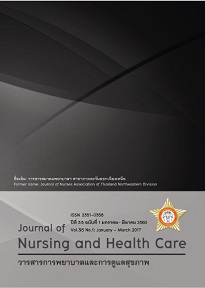การพัฒนาแนวปฏิบัติการพยาบาลผู้ป่วยใช้เครื่องช่วยหายใจในงานดูแลผู้ป่วยหนักโรงพยาบาลตติยภูมิ Development of a clinical nursing practice guideline for mechanically ventilated patients in critical care department of a tertiary care hospital
คำสำคัญ:
ผู้ป่วยใช้เครื่องช่วยหายใจ แนวปฏิบัติการพยาบาล mechanically ventilated patients, clinical nursing practice guidelineบทคัดย่อ
บทคัดย่อ
ผู้ป่วยวิกฤตที่มีภาวะหายใจล้มเหลวจำเป็นต้องได้รับการรักษาด้วยเครื่องช่วยหายใจ แต่การใช้เครื่องช่วยหายใจก็มีความเสี่ยงที่จะทำให้เกิดภาวะแทรกซ้อนด้านร่างกายหลายประการ โรงพยาบาลขอนแก่นเป็นโรงพยาบาลระดับตติยภูมิที่มีหอผู้ป่วยหนักจำนวน 5 หอผู้ป่วยสำหรับดูแลผู้ป่วยผู้ใหญ่ที่อยู่ในภาวะวิกฤติ ซึ่งพบว่าเกิดภาวะแทรกซ้อนจากการใช้เครื่องช่วยหายใจหลายประการ การศึกษาครั้งนี้มีวัตถุประสงค์เพื่อพัฒนาแนวปฏิบัติการพยาบาลในการดูแลผู้ป่วยใช้เครื่องช่วยหายใจและศึกษาผลของการใช้แนวปฏิบัติฯ ดำเนินการศึกษาใน 3 ระยะ คือ ระยะที่ 1 ศึกษาและวิเคราะห์สถานการณ์การพยาบาลผู้ป่วยใช้เครื่องช่วยหายใจ ระยะที่ 2 พัฒนาแนวปฏิบัติการพยาบาลผู้ป่วยใช้เครื่องช่วยหายใจ และระยะที่ 3 ศึกษาผลการนำแนวปฏิบัติการพยาบาลผู้ป่วยใช้เครื่องช่วยหายใจไปใช้ในผู้ป่วย 62 คน (ก่อนใช้ 31 คนและหลังใช้ 31 คน) และพยาบาลวิชาชีพที่ดูแลผู้ป่วยใน 5 หอผู้ป่วยจำนวน 73 คน ดำเนินการวิจัยระหว่างเดือนกุมภาพันธ์ 2559 ถึงเดือนกุมภาพันธ์ 2560
ผลการวิจัยในระยะที่ 1 และ 2 ได้แนวปฏิบัติการพยาบาลผู้ป่วยใช้เครื่องช่วยหายใจที่ประกอบด้วยแนวทางการดูแล 7 แนวทาง คือแนวทางการดูแลผู้ป่วยเพื่อให้มีการหายใจและการระบายอากาศเพียงพอ แนวทางการป้องกันท่อช่วยหายใจเลื่อนหลุด แนวทางการป้องกัน Tracheal injury แนวทางการป้องกันการเกิดปอดอักเสบที่สัมพันธ์กับเครื่องช่วยหายใจ (Ventilator-associated pneumonia: VAP) แนวทางการป้องกันการเกิด barotrauma แนวทางการประเมินความปวดและการจัดการความปวดจากการรักษาด้วยเครื่องช่วยหายใจ และแนวทางการประเมินความพร้อมและได้รับการหย่าเครื่องช่วยหายใจ ในระยะที่ 3 การศึกษาผลของการนำแนวปฏิบัติฯไปใช้พบว่า เมื่อเปรียบเทียบกับผู้ป่วยที่ไม่ได้รับการดูแลโดยใช้แนวปฏิบัติฯ ผู้ป่วยกลุ่มที่ได้รับการดูแลโดยใช้แนวปฏิบัติมีสัดส่วนการเกิด VAP น้อยกว่าถึง 55% (RR 1.55, 95% CI: 0.49-4.95, p = 0.39) ได้รับการประเมินความปวดและจัดการความปวดอย่างเหมะสมทุกคนมากกว่า 20 เท่า (RR 20, 95% CI: 1.12-333.33, p = 0.04) มีความเสี่ยงในการเกิดท่อช่วยหายใจเลื่อนหลุดน้อยกว่า 3.62 เท่า (RR 3.62, 95% CI: 0.82-16.03, p = 0.09) มีโอกาสได้รับการประเมินและจัดการให้หย่าเครื่องช่วยหายใจอย่างเหมาะสมมากกว่ากลุ่มก่อนใช้ CNPG 34.06 เท่า (RR 34.06, 95% CI: 2.13-543.54, p = 0.013) และมีค่าเฉลี่ยจำนวนวันนอนในหอผู้ป่วยหนักน้อยกว่าถึง 3.87 วัน (t = 2.368, p = 0.024) นอกจากนี้ พยาบาลผู้ใช้แนวปฏิบัติยังมีค่าเฉลี่ยความมีวินัยในการปฏิบัติตามแนวทางการดูแลทั้ง 7 แนวทางในระดับที่สูงมาก (95.75%-99.85%) และมีความพึงพอใจต่อการใช้แนวปฏิบัติในระดับสูง (85%) ผลการศึกษาครั้งนี้สะท้อนว่าการดูแลผู้ป่วยใช้เครื่องช่วยหายใจด้วยแนวปฏิบัติการพยาบาลที่สร้างจากหลักฐานเชิงประจักษ์ที่ทันสมัยส่งผลให้เกิดผลลัพธ์การดูแลที่ดีและหากพยาบาลผู้ดูแลผู้ป่วยมีวินัยในการปฏิบัติตามแนวปฏิบัติฯอย่างเคร่งครัด ก็จะส่งผลให้เกิดผลลัพธ์การดูแลที่ดียิ่งขึ้น
Abstract
Critically ill patients with respiratory failure require treatment with mechanical ventilation (MV). However, using MV is associated with several physical complications. Khon Kaen Hospital is a tertiary care-level hospital with 5 intensive care units (ICU) for adult patients with critical illnesses. At present, several complications associated with using MV are reported. This study, carried out in three phases, aimed to develop a clinical nursing practice guideline (CNPG) for mechanically ventilated patients and evaluate effects of implementing the CNPG on selected outcomes. Phase 1 was conducted to analyze existing nursing care intervention for mechanically ventilated patients. Phase 2 was undertaken to develop a CNPG for mechanically ventilated patients. Lastly, Phase 3 was implemented to evaluate effects of implementing the CNPG on selected outcomes among 62 critically ill adult patients (31 patients before and 31 patients after using CNPG) and 73 nurse who cared for these patients in 5 ICUs during February 2016 and February 2017.
Phase 1 and 2 resulted in a CNPG for mechanically ventilated patients that consisted of 7 nursing care guidelines including the guidelines for providing adequate oxygen and ventilation, preventing auto-extubation, preventing tracheal injury, preventing VAP, preventing barotrauma, assessing and managing pain associated with MV treatment, and assessing and promoting mechanical ventilation weaning. Results from Phase 3 indicated that, when compared to patients before using the CNPG, those cared with the CNPG had lower VAP proportion by 55% (RR 1.55, 95% CI: 0.49-4.95, p = 0.39), were 20 times more likely to be assessed and properly managed the pain (RR 20, 95% CI: 1.12-333.33, p = 0.04), had 3.62 times less risk for auto-extubation (RR 3.62, 95% CI: 0.82-16.03, p = 0.09), and were 34.06 times more likely to be assessed for weaning readiness and promoted for mechanical ventilation weaning (RR 34.06, 95% CI: 2.13-543.54, p = 0.013). In addition, those using the CNPG had significantly shorter ICU stay by an average of 3.87 days (t = 2.368, p = 0.024). Lastly, nurses using the CNPG had high level of CNPG adherence in all 7 care guidelines, ranging from 95.75%-99.85% and reported a high level of satisfaction in using the CNPG (85%). Results from this study reflected that an evidence-based CNPG for mechanically ventilated patients was successful in promoting desirable care outcomes. When nurses adhere to the CNPG protocol, effects of thee CNPG on selected outcomes were even more prominent.



